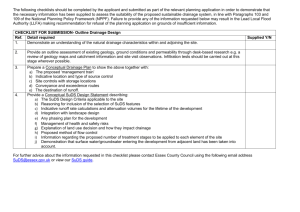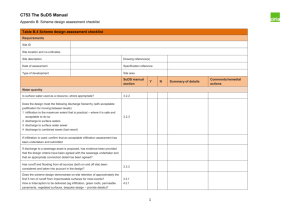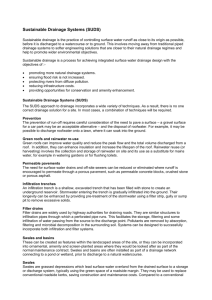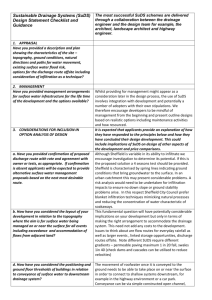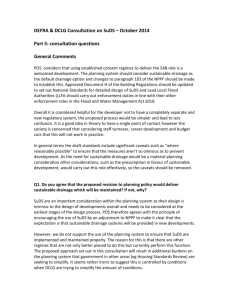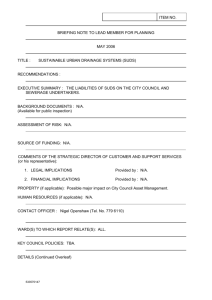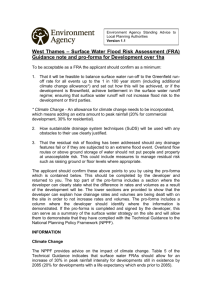SuDSChecklist-detailed-drainage
advertisement
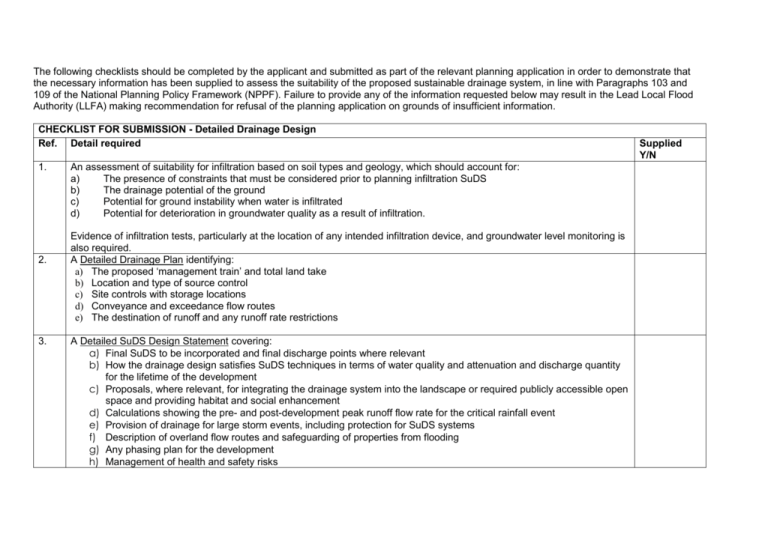
The following checklists should be completed by the applicant and submitted as part of the relevant planning application in order to demonstrate that the necessary information has been supplied to assess the suitability of the proposed sustainable drainage system, in line with Paragraphs 103 and 109 of the National Planning Policy Framework (NPPF). Failure to provide any of the information requested below may result in the Lead Local Flood Authority (LLFA) making recommendation for refusal of the planning application on grounds of insufficient information. CHECKLIST FOR SUBMISSION - Detailed Drainage Design Ref. Detail required 1. 2. 3. An assessment of suitability for infiltration based on soil types and geology, which should account for: a) The presence of constraints that must be considered prior to planning infiltration SuDS b) The drainage potential of the ground c) Potential for ground instability when water is infiltrated d) Potential for deterioration in groundwater quality as a result of infiltration. Evidence of infiltration tests, particularly at the location of any intended infiltration device, and groundwater level monitoring is also required. A Detailed Drainage Plan identifying: a) The proposed ‘management train’ and total land take b) Location and type of source control c) Site controls with storage locations d) Conveyance and exceedance flow routes e) The destination of runoff and any runoff rate restrictions A Detailed SuDS Design Statement covering: a) Final SuDS to be incorporated and final discharge points where relevant b) How the drainage design satisfies SuDS techniques in terms of water quality and attenuation and discharge quantity for the lifetime of the development c) Proposals, where relevant, for integrating the drainage system into the landscape or required publicly accessible open space and providing habitat and social enhancement d) Calculations showing the pre- and post-development peak runoff flow rate for the critical rainfall event e) Provision of drainage for large storm events, including protection for SuDS systems f) Description of overland flow routes and safeguarding of properties from flooding g) Any phasing plan for the development h) Management of health and safety risks Supplied Y/N i) j) 4. The process for information delivery and community engagement to relevant stakeholders System valuation (including capital costs, operation and maintenance costs, cost contributions) and a demonstration of long term economic viability k) Preferred point of connection. l) Proposed method of flow control m) Reason for changes to any previously submitted drainage scheme A Method Statement detailing how surface water arising during construction will be handled. 5. Confirmation of land ownership of all land required for drainage and relevant permissions. 6. A SuDS Management Plan, which provides: a) Details of which body will be responsible for vesting and maintenance for individual aspects of the drainage proposals b) A management statement to outline the management goals for the site and required maintenance c) Description of maintenance schedule and materials and tools needed d) A maintenance schedule e) A site plan including access points, easements and outfalls. Foul drainage proposals. 7. 8. Where required for major developments or phasing of minor developments a plan showing each development plot (e.g. a development block of houses) which shows the allocation of volume storage and discharge rate given to that plot as part of a wider SuDS strategy. For further advice about the information requested in this checklist please contact Essex County Council using the following email address SuDS@essex.gov.uk or view our SuDS guide.
